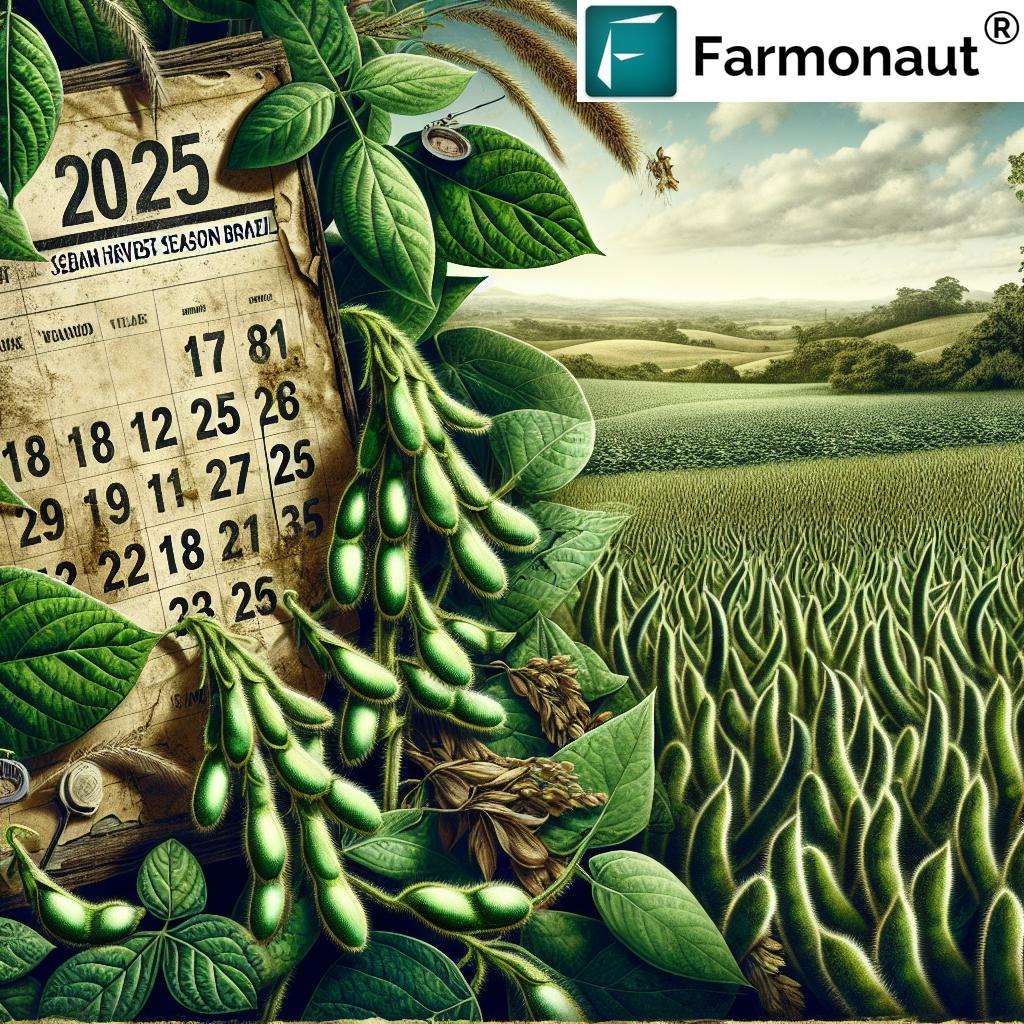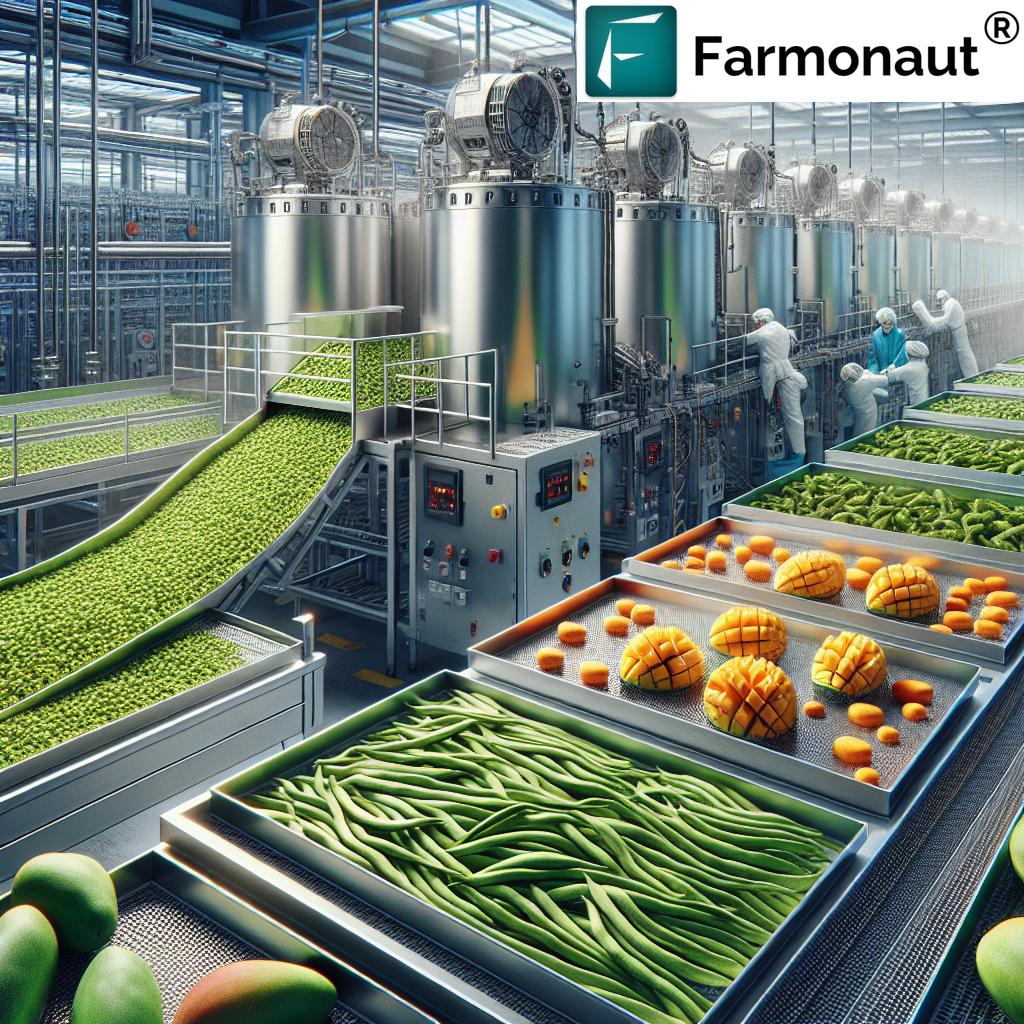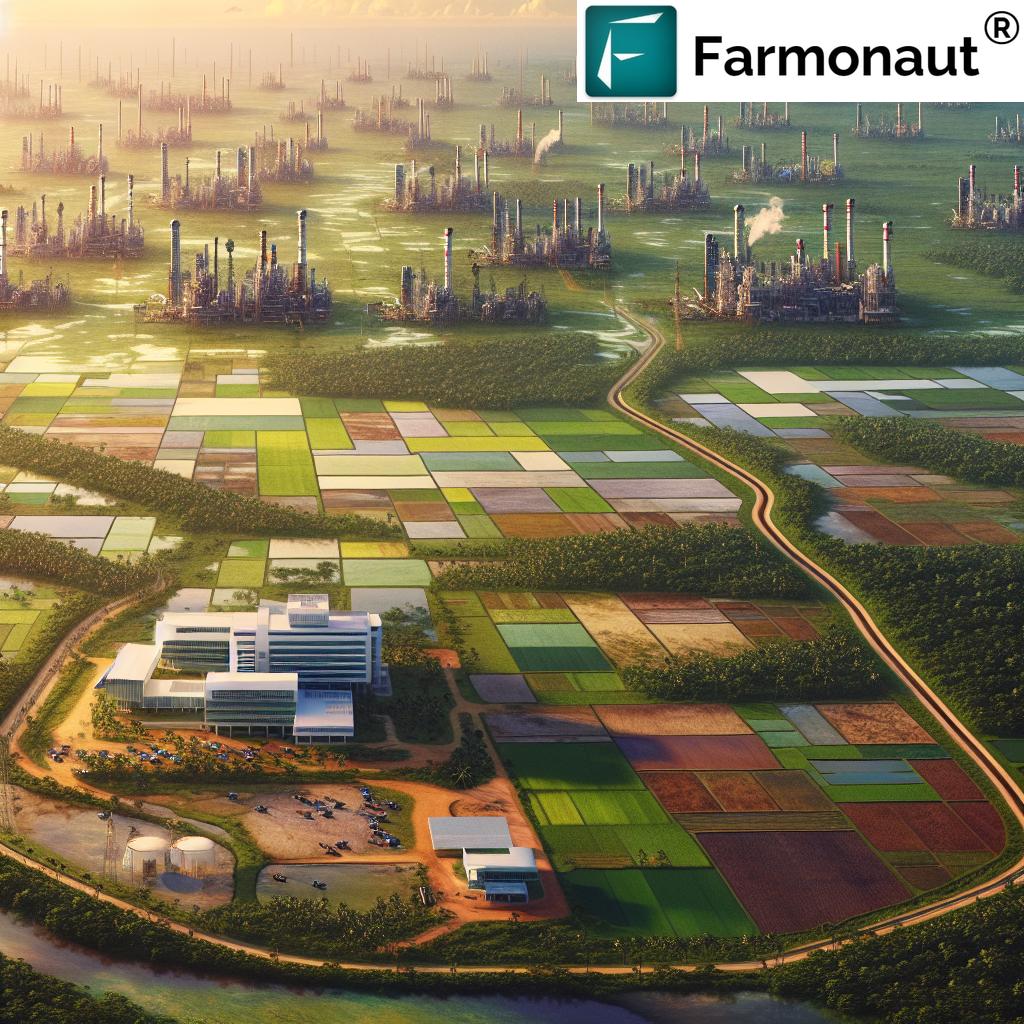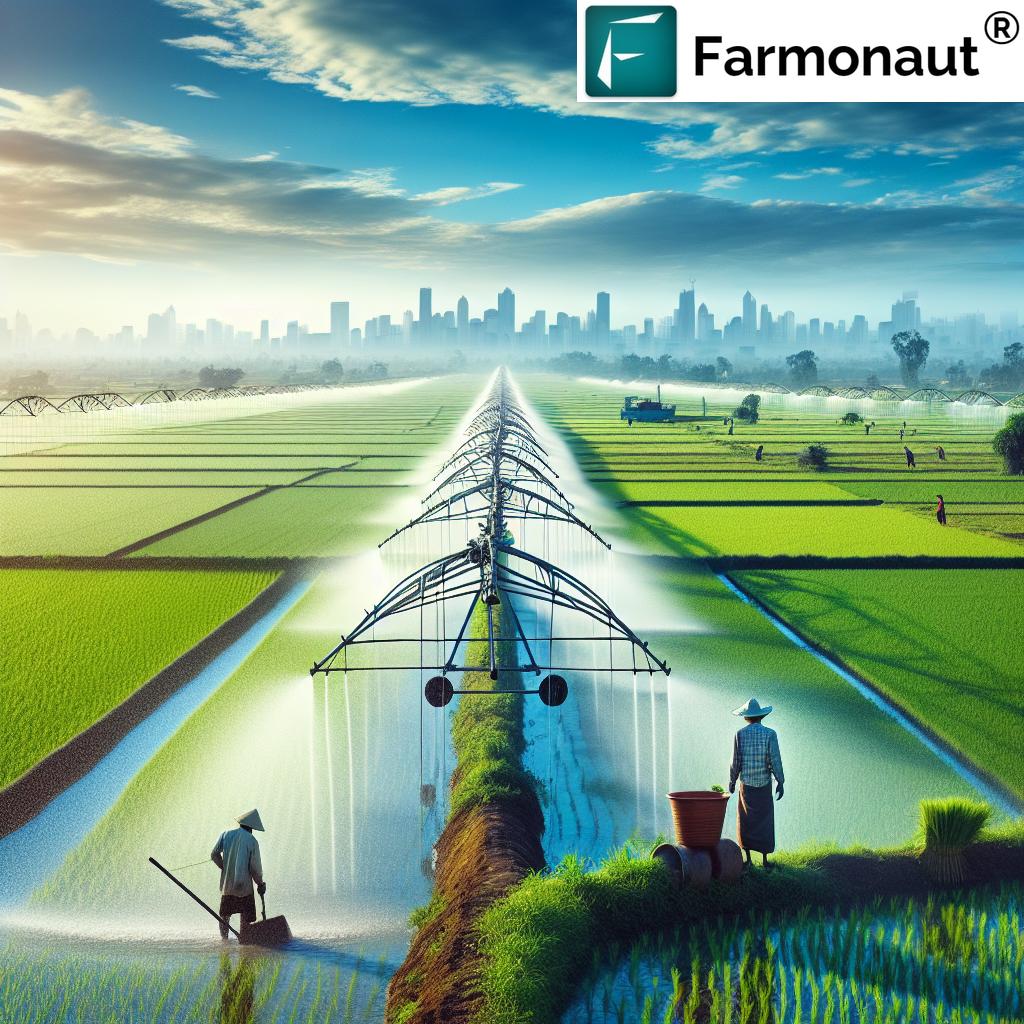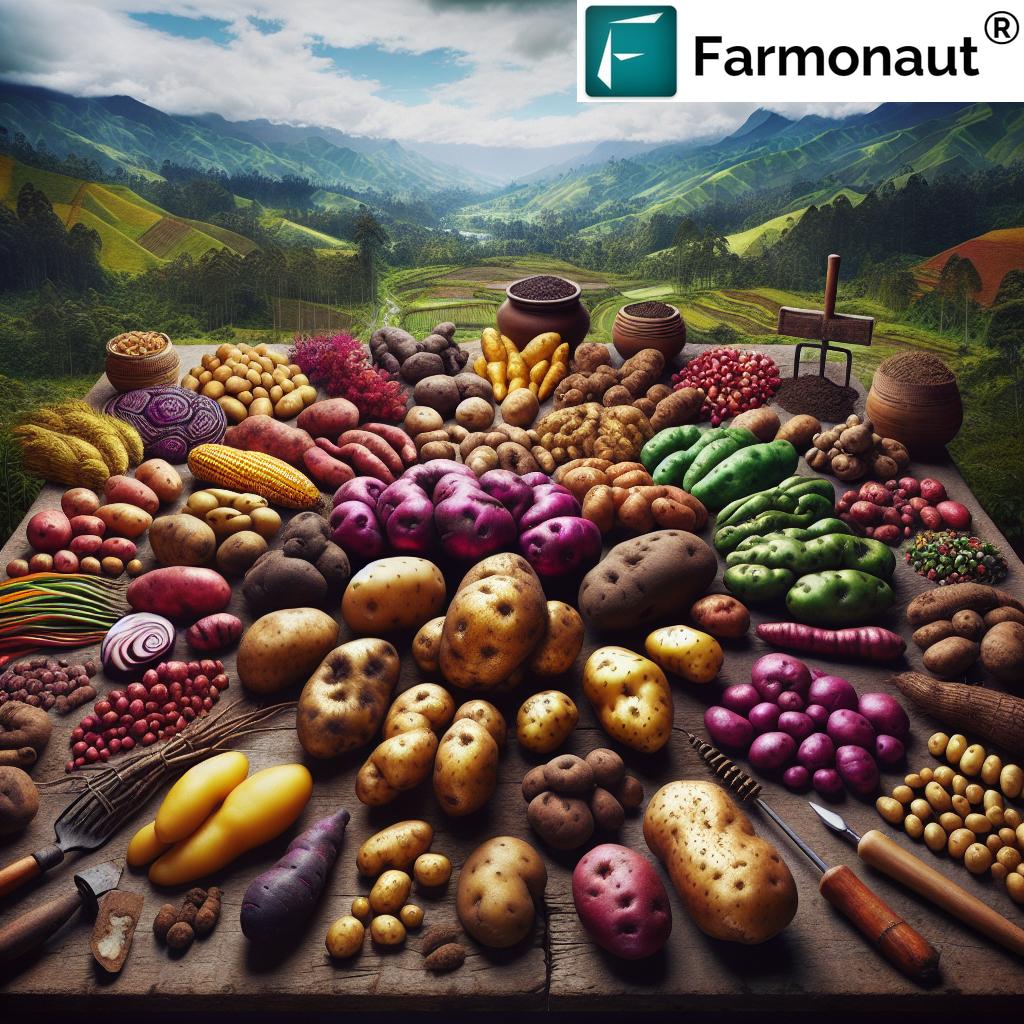Table of Contents
- Introduction: Brazil Soybean Weather Forecast 2025
- Trivia: El Niño & Accurate Weather Impacts
- Brazil’s Climate Zones and Their Influence on Soybean Cultivation
- The Role of Weather in Soybean Production
- El Niño, La Niña & Climate Patterns Affecting Brazilian Soybeans
- Soybean Planting Calendar and Harvest Season in Brazil
- Risks and Management of Diseases: Focus on Asian Soybean Rust
- 2025 Brazil Weather Forecasts for Soybean Farming
- Comparative Regional Forecast & Impact Table (2025)
- Innovative Technology & Forecast Tools: Farmonaut
- Optimal Strategies for Maximizing Yields and Reducing Risks
- Frequently Asked Questions (FAQ)
- Conclusion
- Farmonaut Subscription Plans
“El Niño events can reduce Brazil’s soybean yields by up to 15%, impacting global supply chains significantly.”
Brazil Soybean Weather Forecast: 2025 Shocking Update!
Brazil is the undisputed global leader in soybean production, holding the crown as one of the world’s largest exporters and agricultural powerhouses. Soybean cultivation is not just a crop but a pillar for Brazil’s economy and food systems—and the stakes in 2025 are higher than ever. Climate variability, challenging weather conditions, and major oceanic events (such as El Niño and La Niña) are set to bring both risks and opportunities.
As we analyze the 2025 climate forecasts, we must ask: How will weather patterns, forecasted rainfall, temperature extremes, and disease risks shape this year’s soybean season? And most importantly, what can we do with innovative tools and strategies to optimize yields, manage risk, and stay ahead in farming?
In this authoritative guide, we dive deep into the Brazil Soybean Weather Forecast for 2025, highlight climatic influences on major production zones, unpack the impacts of ENSO events, and explore advanced technology solutions such as Farmonaut to empower farmers and agribusinesses. Whether you farm in Mato Grosso, Paraná, Goiás, or Rio Grande do Sul, our insights will help you plan for a successful crop year.
Leverage Precision Satellite Monitoring for Soybean Crops
Harness Farmonaut’s satellite-based crop health monitoring to access real-time NDVI, moisture, and temperature data for your soybean fields. This advanced technology identifies early stress, detects yield-reducing problems, and guides timely intervention—optimizing your soybean farming across diverse climatic conditions in Brazil.
Access it instantly via the Farmonaut Web & Mobile App:
Brazil’s Climate Zones and Their Influence on Soybean Cultivation
Brazil’s vast territory encompasses multiple climate zones that each uniquely influence soybean growth, yields, and disease risks. Understanding these zones is fundamental for farmers when planning their planting schedules and adapting to weather challenges.
Major Soybean-Producing Regions of Brazil
- Mato Grosso: As the largest soybean-producing state, Mato Grosso features a typical tropical climate with a well-marked wet season (October–March) and a dry season (April–September). Strategic planting is essential to leverage each period for optimal soybean growth.
- Paraná & Rio Grande do Sul: Located in the southern states, these areas experience a subtropical climate—with more evenly distributed rainfall through the year. While this benefits soybean crops, it also brings challenges such as excessive moisture during critical harvest periods.
- Goiás & Minas Gerais: These central states operate under a tropical climate with distinct dry spells. Here, the amount and timing of rainfall during the soybean season play a pivotal role in determining final harvest yields.
The climate diversity across these regions and states not only shapes soybean production in Brazil but also sets the stage for active weather monitoring and precision technology integration.
The Role of Weather in Soybean Production
Weather is a major determining factor for successful soybean yields in Brazil. Farmers across the country must contend with:
- Droughts and Water Stress: Extended periods of drought during the growing season affect soybean plant development, limit pod formation, and reduce overall yields. As seen in the 2014–2017 Brazilian drought, soybean and other crops suffered significant losses due to irregular rainfall.
- Excessive Rainfall and Moisture: Too much rain, especially during planting or harvesting windows, creates delays, damages crops, and can actually increase disease risks. For example, heavy rains in January 2025 impacted soybean, corn, and rice, slowing maturation and complicating harvest operations in main producing areas.
- Temperature Extremes: Optimal conditions for soybean growth exist between 20°C and 30°C. Extended exposure to temperatures above 35°C or below 5°C can halt crop development, damage flowering, and impact yields.
Both high and low extremes in rainfall and temperature underscore the critical importance of accurate weather forecasts for soybean farming in Brazil.
El Niño, La Niña & Climate Patterns Affecting Brazilian Soybeans
The El Niño-Southern Oscillation (ENSO) is among the most powerful global climate drivers, directly impacting the rainfall, temperature, and disease risks for soybean crops in Brazil.
- El Niño: Warmer ocean temperatures shift patterns, often resulting in drier conditions in northern and northeastern Brazil. This increases drought risk and leads to reduced soybean growth, especially when planting coincides with water-stressed periods.
- La Niña: Conversely, cooler ocean currents generate wetter conditions in southern states like Paraná and Rio Grande do Sul. Here, the challenge is managing excess moisture and facing delayed harvesting and increased disease outbreaks.
El Niño impact on soybean yields can be dramatic, lowering national output by more than 15% in severe years. In soy-producing areas, disrupted rainfall and temperature fluctuations directly translate to either reduced harvests or increased disease pressure, depending on the region.
Continuous tracking of ocean temperatures and ENSO cycles is now a must for every soybean farmer in Brazil.
“Accurate weather forecasts in 2025 may help Brazilian farmers optimize planting, potentially increasing yields by 10%.”
Soybean Planting Calendar and Harvest Season in Brazil
To mitigate weather and disease risks, the Ministry of Agriculture in Brazil implements regulatory planting and harvest calendars. These calendars protect crops and keep national soybean production stable.
- Sanitary Void Period: Every year, a mandatory 90-day soybean sanitary void period exists (June to September in many states). During this time, soybean planting is prohibited to block the spread of Asian Soybean Rust (ASR) and related diseases.
- Planting Window: Each state or region receives a set planting calendar. For example, Mato Grosso’s 2024-25 planting starts after September 6 and ends by January 7.
- Harvest Season: Most soybeans are harvested between January and April. However, this can vary with regional rainfall patterns, state-specific regulations, and weather-induced delays.
Following the soybean planting calendar Brazil is crucial for maximizing yield and ensuring compliance with national disease management standards.
Risks and Management of Diseases: Focus on Asian Soybean Rust
One of the biggest yield threats to Brazilian soybeans is Asian Soybean Rust (ASR)—a fast-spreading fungal disease that loves warm, humid climates. Other diseases also thrive in fluctuating moisture conditions.
- Favorable Weather for Disease: Excessive rainfall and extended leaf wetness during the growing period help diseases flourish.
- ASR Management: Regular monitoring of weather forecasts and disease risk maps enables timely application of protective fungicides. The mandated sanitary void period is essential for control.
Thanks to precision technology, farmers can now monitor crop health and disease risks in near real-time using multispectral satellite data and AI-based alerts.
2025 Brazil Weather Forecasts for Soybean Farming: Regional Outlook
Latest forecasts as of June 2, 2025 (sourced from Revista Cultivar) suggest generally favorable conditions for most major soybean regions.
- Mato Grosso (Cuiabá): Sunny, temperatures 20°C–34°C. Ideal window for early-season vegetative growth.
- Goiás (Goiânia): Partly sunny, temperatures 18°C–31°C. Optimal moisture and warmth.
- Paraná (Curitiba): Mostly cloudy, temperatures 12°C–24°C. Favorable but continued rainfall may increase disease risk as harvest approaches.
Taken together, soybean fields across Brazil should experience optimal conditions for growth so long as late-season weather extremes are avoided. However, we must stay vigilant about potential disease outbreaks and waterlogging in southern states.
Comparative Forecast and Impact Table: 2025 Brazil Soybean Regions
| Region | Forecasted Weather (Rainfall mm & Temperature °C) |
El Niño Influence | Estimated Planting Dates | Estimated Yield Impact (% vs. 2024) |
Disease Risk Level |
|---|---|---|---|---|---|
| Mato Grosso | Rainfall: 1200–1600mm Temp: 20–34°C |
Expected mild El Niño; potential dry spells mid-season | Sept 7–Jan 7 | +2% to +5% | Medium (ASR risk in wetter pockets) |
| Paraná | Rainfall: 1300–1800mm Temp: 12–26°C |
Potentially above avg. rainfall, cooler night temps | Oct 1–Dec 10 | 0% to -3% | High (moisture-linked diseases) |
| Rio Grande do Sul | Rainfall: 1100–1350mm Temp: 14–28°C |
Minor La Niña effect; increased late-season rains possible | Oct 15–Dec 20 | -1% to -5% | High (root rot, ASR) |
| Goiás | Rainfall: 1100–1400mm Temp: 18–31°C |
Slight warming, occasional dry spells | Sept 7–Nov 30 | +1% to +3% | Medium (ASR & leaf spot) |
| Minas Gerais | Rainfall: 1100–1450mm Temp: 19–32°C |
El Niño risk moderate; dry spells possible | Oct 5–Dec 10 | 0% to +2% | Medium |
This comparative forecast and impact table lets us see at-a-glance which soybean regions in Brazil will face the greatest weather, yield, and disease risks in 2025. For more detailed, field-specific monitoring data, connect with Farmonaut’s Agro Admin App for large scale farm management across climate zones.
Farmonaut: Next-Gen Technology for Weather, Forecasts, and Soybean Farming
Precision and adaptability power modern soybean farming. In 2025, digital innovation is every grower’s best asset against unpredictable climate and complex disease challenges in Brazil. With Farmonaut, we enable actionable decisions with powerful features:
- Satellite-Based Crop Health Monitoring: Monitor NDVI, soil moisture, canopy temperature, and stress—with near-real time updates for every field block. Highly useful for Mato Grosso soybean cultivation and multi-region operations.
- Jeevn AI Advisory System: Our AI delivers field- and crop-specific advisories, weather outlooks, and risk/response strategies, adapting to the exact climatic conditions and forecast patterns in your region.
- Integrated Weather Forecasts: Receive hyper-local forecasts, drought warnings, rainfall probabilities, and temperature spikes, all referenced directly to your soybean zones.
- Blockchain Traceability: Guarantee that every harvested ton of soybeans is verifiable and authentic throughout the supply chain with product traceability solutions.
- Fleet & Resource Management: The Farmonaut fleet manager optimizes logistics and field operations—lowering costs and amplifying efficiency during high-pressure planting and harvest seasons.
- Carbon Footprinting: Track greenhouse emissions on your farm and work towards sustainability goals with Farmonaut’s carbon footprint platform. Meet buyer and regulatory requirements with confidence.
- Crop Loan & Insurance Verification: Simplify financing and claims using transparent satellite-based data—see more at crop loan and insurance support.
All these advanced technologies are accessible via a unified app experience—just a click away for every farmer, cooperative, or agribusiness.
Optimal Strategies for Maximizing Yields and Mitigating 2025 Risks
Based on detailed weather forecasts, region-specific climate risks, and advances in agri-technology, here’s how we can ensure a resilient and profitable soybean season in Brazil in 2025:
For All Soybean Farmers
-
Monitor Weather Patterns Continually:
Use Farmonaut’s real-time weather and crop health data throughout the season—especially during critical planting and harvesting periods. -
Plan Around Official Calendars:
Always follow the sanitary void period and recommended planting windows (e.g., September to November in Mato Grosso). -
Select Varieties Suited for Regional Climates:
Plant varieties with proven resistance to heat, drought, or excessive moisture, depending on your state/region’s climate. -
Adopt Integrated Disease Management:
Combine crop rotation, field sanitation, weather-based fungicide applications, and strict adherence to the soybean planting calendar Brazil. -
Implement Resource Optimization Tools:
Minimize input and operational costs—be it water, fertilizer, or vehicle fleets—using digital management systems. See the fleet manager and carbon tracking solutions. -
Stay Informed on ENSO updates:
Monitor El Niño and La Niña bulletins all season—using your Farmonaut dashboard.
Key State-Specific Strategies
- Mato Grosso: Plant as soon as permitted post-sanitary void; track early-rain onset; apply proactive disease controls during peak humidity.
- Paraná & Rio Grande do Sul: Be ready to harvest early if heavy rains close in; prioritize root rot and ASR monitoring.
- Central States (Goiás, Minas Gerais): Use drought-tolerant cultivars; maintain flexible irrigation plans; adjust fertilizer schedules by satellite data.
Frequently Asked Questions (FAQ)
-
Q: What is the most important climate risk for soybeans in Brazil in 2025?
A: The biggest risks are highly variable rainfall, drought spells caused by El Niño, and localized excessive moisture increasing disease—especially Asian Soybean Rust risk in southern states. -
Q: How can I track field-specific soybean health and moisture levels throughout the season?
A: With Farmonaut’s satellite monitoring, accessible via web or mobile app, any farmer can view NDVI, soil moisture, crop stress indices, and growth trends in real time. -
Q: What is the sanitary void period and why is it important for soybean production?
A: It’s a state-mandated 90-day window (June to September in many regions) when soybean crops aren’t permitted in the field. This breaks pest/disease cycles (especially for ASR) and stabilizes national yields. -
Q: What are the latest recommended planting dates for 2025 in Brazil’s main soybean regions?
A: Most planting begins after September (Mato Grosso, Goiás), October/November (Minas Gerais, Paraná), and wraps up by early January depending on region and rainfall. -
Q: How does Farmonaut help agribusinesses with traceability and compliance?
A: The product traceability system leverages blockchain to register and track crop movements from planting to export—creating transparent, tamper-proof records for buyers and regulators.
Conclusion: The 2025 Brazil Soybean Outlook
We stand at a critical juncture for soybean production in Brazil in 2025. With the immense diversity of climate zones, increasing unpredictability from events like El Niño and La Niña, and ongoing threats from diseases, both challenges and opportunities abound.
The most successful farmers this season will be those who:
- Leverage accurate, local weather forecasts,
- Utilize advanced technology for monitoring and risk management,
- Anticipate disease outbreaks via satellite and AI-based alerts,
- Implement region-optimized strategies and adhere to sanitary planting calendars,
- Aim for both high yields and sustainable, verified supply chains.
Farmonaut’s real-time, AI-powered, and satellite-driven platform makes all this accessible for every scale of farming—whether in the heart of Mato Grosso, the far reaches of Goiás, or the rich fields of Paraná and Rio Grande do Sul. Let’s embrace innovation, stay agile, and make 2025 a record year for Brazilian soybeans.
Farmonaut Subscription Plans
Get started with affordable, flexible subscriptions tailored for individual farmers, cooperatives, government agencies, and agribusinesses. Customize services by your area, forecast needs, and frequency of updates.





